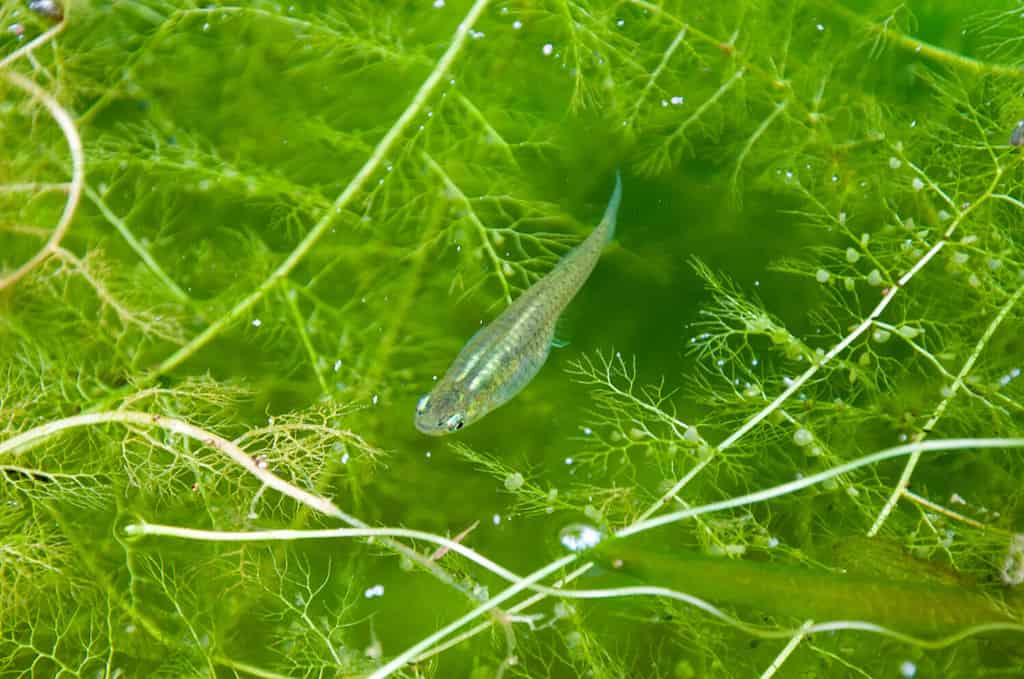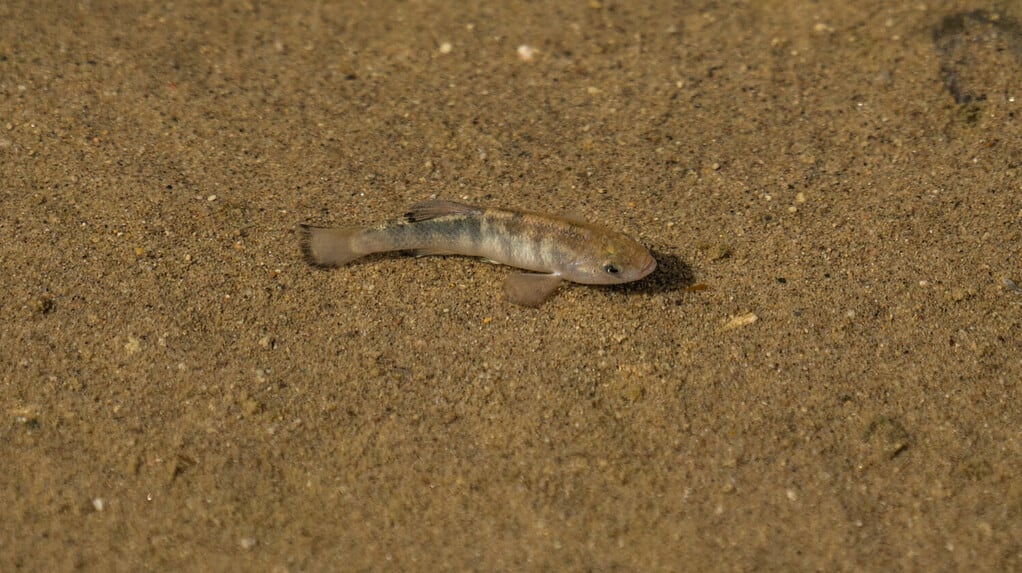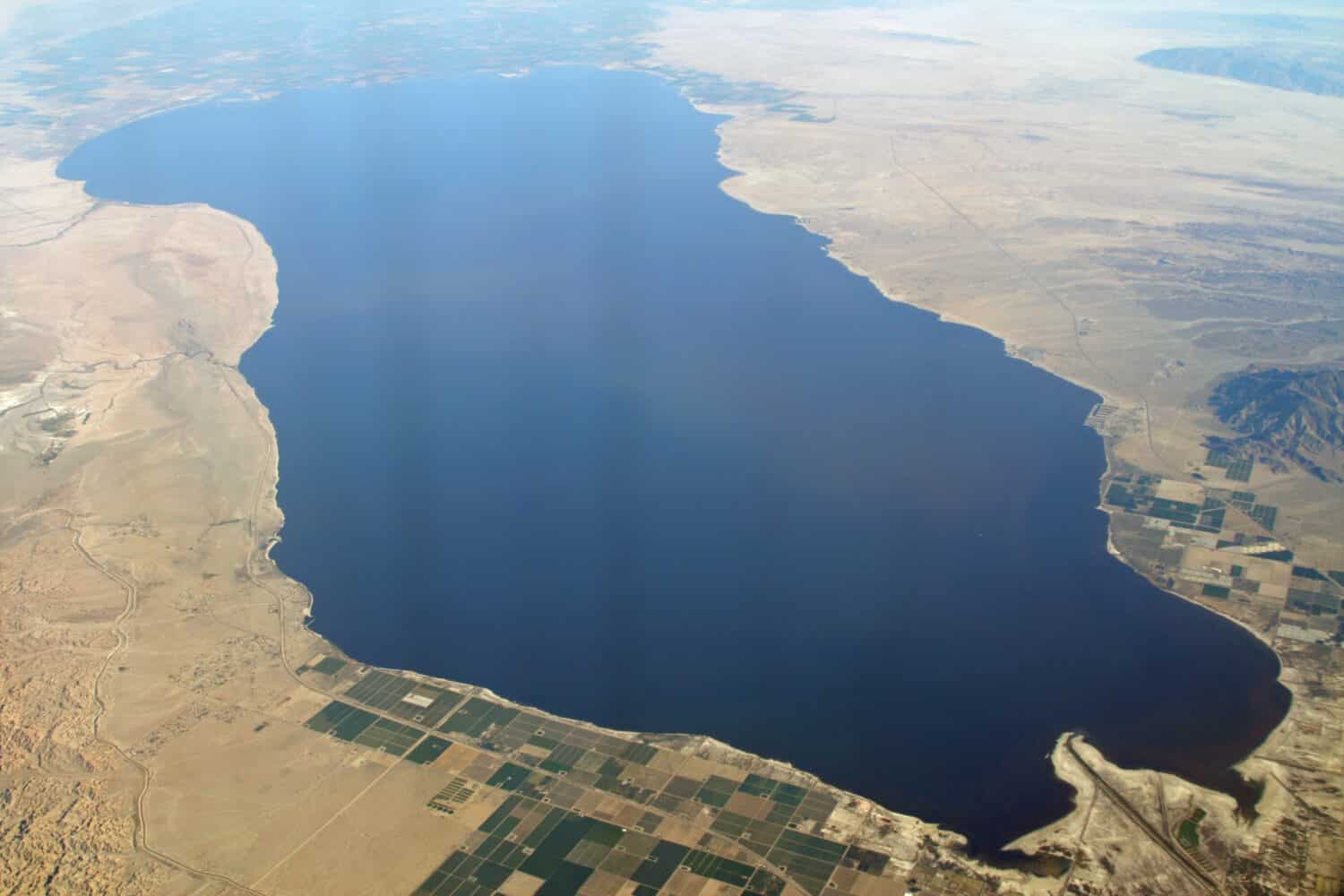The Salton Sea, California’s grandest lake, has a fascinating origin story. It came into being by chance in 1905 when a canal from the Colorado River ruptured and flooded an arid basin. Today, this shallow water body has become a haven for avid anglers and migratory birds alike.
However, it’s not without its share of ecological predicaments, including but not limited to heightened salinity levels, pollution, and water scarcity. This article will explore more intriguing aspects of this mysterious lake, such as its size, depth, fishing possibilities, and other noteworthy details.
What is the Salton Sea?

The Salton Sea is just as salty as it sounds.
©bonandbon/Shutterstock.com
The Salton Sea is a parched salty body of water in the Sonoran Desert of Southern California. It’s the biggest lake in the state, spanning around 343 square miles (890 square kilometers). The San Andreas Fault runs through it. The lake lies within the Salton Trough, extending towards the Gulf of California (Sea of Cortez) in Mexico.
The lake has no outlet to the ocean, so its water level and salinity depend on the balance between inflow and evaporation. Water supply to the lake comes from various sources, including the New Whitewater and Alamo rivers, agricultural runoff, drainage systems, and surrounding creeks.

Size and Depth
The lake’s dimensions vary periodically, depending on the rainfall and water that enters it from the surrounding areas. Typically, the lake spans about 24 kilometers wide and 56 kilometers long, with a maximum depth of roughly 13 meters. The lake receives an influx of approximately 1.5 cubic kilometers of water every year, which generally suffices to maintain its depth.
However, this amount may fluctuate slightly. The lake’s deepest point is near Bombay Beach on the eastern shore, where it reaches 51 feet.
How the Salton Sea Was Formed
Around 1100 years ago, a massive body of freshwater dubbed Lake Cahuilla occupied the Salton Basin. Fueled by the Colorado River, this lake swelled to nearly six times the current expanse of the Salton Sea. Its stunning shoreline can still be observed in the nearby mountains.
Lake Cahuilla was crucial in sustaining the Native American communities that resided in the surrounding regions. They relied on its abundant resources, utilizing the shoreline to establish settlements and camps, casting their nets to catch fish in its teeming waters, and using the delta’s nutrient-rich soil to grow crops.
The Last Lake Cahuilla

An aerial view of the Salton Sea, surrounded by the Imperial Valley and the Mojave Desert.
©Thomas Barrat/Shutterstock.com
Around 1500 AD, Lake Cahuilla ceased to exist as the Colorado River changed its course and stopped flowing into the Salton Sink. Consequently, the lake evaporated and gradually diminished in size, revealing its salt deposits and creating a desolate and arid terrain. The Native Americans residing in the area had to either acclimate to the altered circumstances or relocate to a different location.
For the next 500 years, the Salton Sink remained mostly dry, except for occasional Colorado River floods or local rainfall. It wasn’t until the early 20th century that a new lake would form in the Salton Sink, but this time it wasn’t by natural causes.
The Accidental Creation of the Salton Sea
The formation of the Salton Sea dates back to 1905 when an artificial catastrophe unexpectedly transformed into a striking natural phenomenon. Back then, farmers in the Imperial Valley were searching for a dependable water supply to nurture their crops. To fulfill their need, they engaged the services of the California Development Company to construct a canal from the Colorado River to their fields. Unfortunately, the channel turned out to be inadequately built and couldn’t cope with the enormous silt content of the river.
To increase the water flow, engineers cut a new channel in the river bank, hoping to divert some of the water into their canal. Unfortunately, they underestimated the power of nature and unleashed a torrent of water that overwhelmed their canal and flooded into the Salton Basin. Almost all of the Colorado River’s flow poured into the basin for two years, creating a lake that covered about 343 square miles.
Engineers and laborers tried hard to seal the breach. Finally, in 1907, the flood stopped. The Salton Sea has remained a constant aspect of the scenery since that time, nourished by agricultural runoff from nearby farms. Moreover, it has become a well-liked spot for sightseers and fishermen, who delight in its temperate waters and ample fish population.
The Environmental Challenges of the Salton Sea

The Salton Sea houses numerous bird species and other wildlife that rely on its wetlands for nourishment and refuge.
©Josh Cornish/Shutterstock.com
The Salton Sea doesn’t have a natural way to drain itself. It depends mainly on irrigation runoff and rainfall inflows to offset the water that evaporates. Unfortunately, this means that the sea has grown saltier and more contaminated as time has passed. According to sources, the Salton Sea is about 50% saltier than the ocean. Few aquatic creatures like Tilapia can survive there. The excess salt also leads to massive fish die-offs, which produce unpleasant smells and health risks.
It gets polluted due to the agricultural runoff that transports pesticides, fertilizers, and other harmful substances into its waters. These contaminants can trigger the growth of algal blooms, which reduce oxygen levels and make the environment unsafe for aquatic creatures and wildlife. Furthermore, as the water recedes, the pollutants can turn into dust particles and spread through the air, revealing dry lakebeds.
The Salton Sea houses numerous bird species and other wildlife that rely on its wetlands for nourishment and refuge. It’s an essential stopover point along the Pacific Flyway, where millions of birds migrate yearly. Nevertheless, as the Salton Sea diminishes and declines, it endangers the survival of these creatures and their environments.
What About Lithium in the Salton Sea?
As the Salton Sea continues to recede, more and more lakebed is exposed, which has led to the discovery of lithium beneath it. Lithium is needed for rechargeable batteries for mobile phones, laptops, digital cameras, and electrical vehicles, so it is much in demand.
Industry predictions are that the Salton Sea could supply an as much as 600,000 tons per year with a value of $7.2 billion. But first, appropriate mining technology needs to be developed. Then there’s the problem of finding a workforce and the infrastructure to support such a workforce. Nonetheless, construction on mining facilities may start in 2024.
However, the environmental impacts of lithium mining are not completely understood. Therefore, although the lithium could bring a huge economic boost to a depressed area with one of the highest poverty rates in the state, it is unclear whether extracting the lithium from underneath the Salton Sea lakebed could cause health risks for the local residents. Already the contamination in the Salton Sea may be related to the high number of asthma cases in the area.
What Fish Can You Catch In The Salton Sea?
The Salton Sea hosts some fish species that can endure a challenging environment. However, most of them are invasive and adversely affect the indigenous ecosystem. Here are fish species inhabiting the Salton Sea and their distinct traits.
Mozambique Tilapia (Oreochromis mossambicus)
The Mozambique tilapia, originally from southern Africa, is abundant in the Salton Sea due to its adaptability to harsh conditions like high salinity and low oxygen levels. Mozambique tilapias have a varied diet as they are opportunistic omnivores, consuming plant matter, algae, organic particles, and small invertebrates.
This diverse palate allows them to adapt to various habitats without depending on any specific food source. Despite its resilience, this invasive species harms the local ecosystem by disrupting the food chain and competing with native fish. Nonetheless, its spread worldwide is due to its popularity in culinary and aquaculture settings.
Redbelly Tilapia (Coptodon Zillii)
The Salton Sea also hosts the redbelly tilapia, a cichlid breed from northern Africa and the Middle East. This fish was introduced to various areas for ornamental purposes or aquaculture. Its exceptional resilience to high salinity and low oxygen levels is noteworthy. They mainly eat underwater plants and tiny organisms like algae and diatoms, accounting for over 80% of their food. Additionally, they consume fish eggs, water bugs, and crustaceans, making up the rest of their diet.
Wami Tilapia (Oreochromis Urolepis)
The Salton Sea houses the Wami tilapia, a cichlid species from eastern Africa, which has been introduced in many areas for aquaculture or sport fishing. The Wami tilapia is well adapted to thrive in environments with high salinity and low oxygen levels. It’s an omnivore that feeds on algae, small invertebrates, residue, and plants like other Tilapia. However, the Wami tilapia threatens native fish and disrupts the food web as an invasive species.
Western Mosquitofish (Gambusia Affinis)

can be found in the Salton Sea.
©Lorenzo Sala/Shutterstock.com
The western mosquitofish, a small fish that gives birth to live young, can be found in the Salton Sea. It was brought in deliberately from North America to help control mosquitoes. These fish are tough and can withstand high salt levels and low oxygen. They eat mosquito larvae to reduce their numbers. They also consume insects and plants. However, they threaten native fish by preying on their eggs and larvae, jeopardizing their survival in the Salton Sea.
European Carp (Cyprinus Carpio)
This fish originally comes from Europe and Asia, but people have introduced it to many countries for fishing and food. It’s big, often over a meter long, and weighs up to 60 kg. Even though it’s not from here, the European Carp has done well in the Salton Sea. It can survive in salty, oxygen-poor water, which is pretty impressive. Based on availability, it consumes various items, ranging from tiny bugs to mollusks, seeds, and crustaceans.
However, the European Carp is wreaking havoc in the Salton Sea’s ecosystem. This unwanted species is a significant danger and causes a lot of trouble. When it eats, it wrecks important plants that other creatures need to live. Not only that, but it’s also making the water dirty, causing problems for other animals to breathe and see. These issues could lead to big trouble, messing up the whole food chain and ecosystem.
Desert Pupfish (Cyprinodon Macularius)

is considered an endangered species.
©clayton harrison/Shutterstock.com
The Salton Sea has a unique fish called the desert pupfish, endemic to the Colorado River basin. This little fish can live in many aquatic environments, like springs, streams, ponds, and lakes. It’s good at adapting and can survive in harsh environments that would kill other fish. The desert pupfish eats many things, like algae, insects, crustaceans, and leftovers.
Sadly, the desert pupfish is in trouble. Buildings and water changes are destroying its homes. Also, invasive creatures like European Carp, dirty farm water, and other pollution pose a danger. Predation and competition also contribute to the decline of the desert pupfish population. As a result, it’s now considered an endangered species.
Red Shiner (Cyprinella Lutrensis)
The Red Shiner is a fish species native to the Mississippi River basin from southern Wisconsin and western Indiana. You can find them swimming around in different bodies of water throughout North America, like rivers, lakes, and streams. These fish are tough and can live in places with much salt and little oxygen.
Regarding diet, the red shiner is omnivorous and eats aquatic and terrestrial invertebrates and algae. However, it has been observed that in introduced areas, it preys on the eggs and larvae of native fish, which can significantly reduce their population.
Although not classified as invasive, the red shiner’s presence can still impact the genetic diversity of other native cyprinids through hybridization.
Bairdiella (Bairdiella Icistia)
Bairdiella fish, or drums or croakers, make sounds by shaking their swim bladders. They were introduced to the lake as a fun fish to catch in the 1950s. Bairdiella icistia, a specific type of Bairdiella fish, is tough and can survive in the lake’s harsh conditions of high salinity, temperature, and low oxygen levels.
This fish likes shallow areas with sandy or muddy bottoms where it can chow down on small creatures. Despite not being a colossal fish, it has the potential to attain a size of 30 cm (12 in), making it relatively considerable compared to the other fish present in the lake.
Orangemouth Corvina (Cynoscion Xanthulus)
The orangemouth corvina is a fish, part of the Sciaenidae family, and goes by other names like drums or croakers. It originates from the Gulf of California and the Pacific coast of Mexico. Strangely, it’s now also in the Salton Sea in California, where it’s pretty common. This fish can reach a size of 90 cm (35 in) and 24 kg (54 lb).
The orangemouth corvina prefers to dwell in shallow, brackish waters with sandy or muddy bottoms. This species can easily adjust to the Salton Sea’s varying levels of saltiness and temperature. Regarding food, the Orangemouth corvina feeds on smaller fish, mollusks, and crustaceans.
Where Can You Find The Best Fishing Spots In The Salton Sea?
Here are some of the best spots to fish in the Salton Sea:
- Bombay Beach
- North Shore Beach and Yacht Club
- Mecca Beach
- Salt Creek Marina
- Red Hill Marina
Fishing Season in Salton Sea

For best results, consider fishing in the Salton Sea at night or early morning when the wind is calm, and water visibility is improved.
©Jacob Findlay/Shutterstock.com
Pinpointing the exact fishing season can be challenging. The recommended period for fishing in the Salton Sea typically occurs in late autumn to early spring. During this time, the water temperature is lower, and fish exhibit higher activity levels.
For improved results, consider fishing at night or early morning when the wind is calm, and water visibility is improved. It is worth noting that fishing outcomes are unpredictable and affected by various factors such as weather, algae blooms, and water levels. Therefore, checking the prevailing conditions before venturing into the lake is advisable.
Is Salton Sea Fish Safe to Eat?
The safety of consuming fish from the Salton Sea is questionable due to the accumulation of harmful substances such as salinity and selenium in their tissues. These factors present several health risks to humans.
In 1986, the Office of Environmental Health Hazard Assessment (OEHHA) provided a health advisory that recommended the consumption of only 114g (4 oz) of fish from the Salton Sea every two weeks.
Thus, regularly consuming fish from this lake is not advisable, and following the guidelines mentioned above is crucial if you choose to consume fish from the Salton Sea.
Fishing in the Salton Sea is a Must-Try Experience
The Salton Sea holds a wealth of California’s past and offers an exceptional location for angling with diverse fish kinds like Tilapia and Corvina. Moreover, it serves as a sanctuary for uncommon and endangered species, yet the situation seems dire. The water quality and quantity are declining, and the general environment is deteriorating, potentially jeopardizing human health. Thus, immediate action is imperative to preserve this unique ecosystem for posterity.
Where is the Salton Sea Located on a Map?
The Salton Sea is located between Highways 111 and 86 that run along its east and west sides. Another way to locate the Salton Sea: it is between the great agricultural center of the Imperial Valley–with its towns of Calexico on the Mexican border, El Centro, Brawley, and Westmoreland–and the famous quad cities of Indio, Palm Desert, Cathedral City, and Palm Springs.
Thank you for reading! Have some feedback for us? Contact the AZ Animals editorial team.








